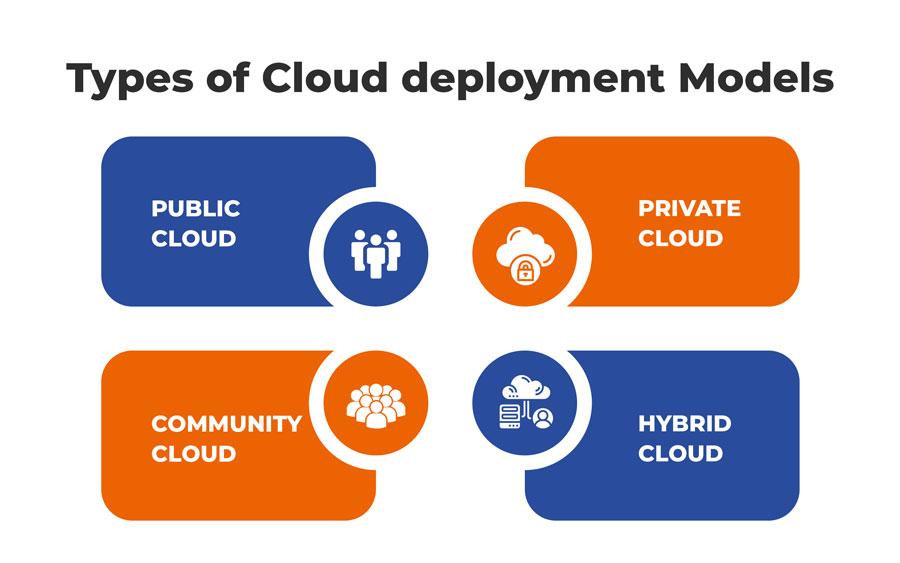Cloud deployment is the process of integrating software-as-a-service (SaaS), platform-as-a-service (PaaS), and infrastructure-as-a-service (IaaS) into the cloud to serve as a tool that enables users to access data. Enterprises, businesses, and even banks use a variety of cloud deployment models. These models can be community-based, private, public, or hybrid. The models are constructed using a variety of variables. When companies choose to have a cloud deployment model, the requirements of the customer or user and the organization’s needs are considered. Banks and other financial service providers are now using cloud deployment. Banks can centralize many of the services they provide to make them more practical and user-friendly by using a cloud-native platform.
What is cloud deployment?
Cloud deployment is the use of cloud environments to run applications using various models, including infrastructure-as-a-service (IaaS), platform-as-a-service (PaaS), and software-as-a-service (SaaS) (IaaS). Organizations can use a cloud solution to lower capital expenses (CAPEX) and enable flexible operational costs (OPEX) in response to shifting needs. Computing resources can be relocated from a company’s physical location and made to exist only on a cloud platform, thanks to cloud deployments. Through the use of multiple servers, online virtual machines, and online data centres for increased storage capacity, businesses can access improved computing power in this way. Different computing environments, such as public, private, community, and hybrid clouds, are also possible with cloud deployment.
You may also like to read about – A Comprehensive Guide on Big Data in the Cloud Computing
What is the cloud deployment model?
A cloud deployment model determines the location and manager of your servers. It outlines your cloud infrastructure’s appearance, what you can change, and whether you get services already built for you or have to create everything from scratch. Additionally, cloud deployment models specify the connections between your users’ infrastructure (what users are allowed to change or implement).
When you hear “cloud” or “cloud computing,” you likely picture shared computing resources. It’s only one of a few examples of cloud deployment models, though. There are also others. Typically, we refer to the “public cloud” when we discuss the cloud. One cloud deployment model in which the cloud provider owns and controls every server is that one.
But let’s say you have some physical servers of your own in addition to using a public cloud, and you want to use both as a single system. Then, we’re discussing a “hybrid cloud”—another approach to deploying clouds. You might still have “a cloud” even if you never use the public cloud. If deployed and explicitly managed, your data centre could turn into a “private cloud.”
These choices are all various cloud deployment models. Your cloud deployment model depends on how you use and provision your cloud infrastructure. However, all models should be similar from the user’s point of view. For instance, a “private cloud” in your data centre must offer comparable choices and a public cloud’s features. It’s also not a hybrid cloud if you use your data centre separately from a public cloud.
Types of Cloud deployment Models
You might wonder why there are so many different cloud deployment models available and which one is best for you. Because cloud computing is practical and has gained popularity, we have these models.

Companies attempt to simultaneously use their current data centres as efficiently and featurelessly as possible. For various reasons, some businesses can’t just switch to the public cloud. For instance, compliance and data protection laws might prohibit them from using the public cloud. They might also be hesitant to switch to the public cloud because they want to continue using the previously purchased servers after spending a fortune on them. We have several cloud deployment models to accommodate all potential scenarios because of this.
Public cloud
The most common kind of cloud is the public cloud deployment model. Additionally, it’s the one that comes to mind when someone mentions “cloud.” The fundamental idea is that you don’t own any hardware when using a public cloud. A cloud service provider gives you access to all the resources. Therefore, an account is required to begin using the public cloud. According to this model, “public” refers to a cloud that is open to all users and whose resources are shared.
Scalability, efficiency, and the lack of hardware requirements are the main benefits of the public cloud. Consider creating a platform that occasionally handles a heavy load. You would have to make some concessions if there were no clouds. Purchasing sufficient servers to handle the peak load is one option. However, that would imply that all those servers would be underused most of the time. A different choice would be to purchase only as many servers as necessary to manage the average load, but your application would perform poorly with sporadic spikes.
You can have both with the public cloud—enough resources for load peaks without making sizable upfront investments. Additionally, you can provision resources on an as-needed basis and even have load-based autoscaling, and you only pay for the resources you use. In addition to primary virtual machines and storage, cloud providers provide a wide range of public cloud services. Some examples of public cloud deployment models examples include Amazon Web Services (AWS), Microsoft Azure, IBM Cloud, and Google Cloud.
Private Cloud
The deployment model for private clouds is the polar opposite of public clouds. It is the sole user’s dedicated environment (customer). The hardware is typically all yours; you don’t share it with other users. What distinguishes a private cloud from a “typical/ordinary” on-premises data centre? The distinction lies in how you handle all of the hardware.
When you operate your data centre similarly to public cloud service providers, you are operating a private cloud. Your physical servers are covered with an abstraction layer that you create. You have flexibility like a public cloud, thanks to this. You have flexibility like a public cloud, thanks to this. With a private cloud, you won’t need to worry about configuring new servers when you add them to your data centre because they will (semi)automatically join the cluster. A public cloud provider may also be able to provide you with a private cloud. It implies that a cloud service provider will separate some resources from the rest of its cloud and make them exclusively yours. But the point is that resources are allocated to a single organization, whether you have your private cloud in your data centre or a cloud provider.
Hybrid cloud
The hybrid cloud deployment model combines a public and private cloud, as you might have guessed. Because many businesses already own hardware and want to use it, it is the second most popular model. A hybrid cloud is one where a business uses both on-premises and public cloud resources, with a connection between the two. They operate as a single system. It is an efficient model that enables a gradual migration to the public cloud over time. Some businesses can’t operate exclusively in the public cloud due to security or data protection requirements, so they may choose the hybrid cloud to combine their needs with the advantages of a public cloud. They keep sensitive data and mission-critical applications running on-premises while using the public cloud for everything.
Conclusion
Over time, the cloud has undergone significant change. It was initially just an unusual choice with few variations. There are wide varieties available today, and you can even build your private cloud in your data centre. You gained knowledge of the available cloud service and deployment models. It’s crucial to remember that there are now additional options besides the public cloud. Running your private cloud in your data centre may be the most effective way to manage your IT infrastructure for some. Regardless of which cloud deployment model will work best for you, you still need to choose the best software deployment strategy. Over time, the cloud has undergone significant change. It was initially just a novel choice with few advantages. Learn how to quickly and fearlessly deploy software to the cloud using canary launches and dark launches to make wise decisions in this situation (enabled by Launch Darkly). Learn how to migrate databases to the cloud smoothly and without incident using the LaunchDarkly feature flags.



In the age of recent technology more and more work is shifting online and tons of content and data is required to be stored. Cloud storage and its deployment model provides an additional edge benefit to the fashionable world because it’s difficult to hold heavy hard drives and that they do take up a lot of space. Having learned more about cloud deployment models from this blog , I now have a better understanding of how it could help a private ,firm or public. As a result, they provided precise information about various cloud deployment models, like private, hybrid, public, and community models and which is really suitable that scenario. as an example, for one individual, the private model is that the best, while hybrid models work better for businesses. Explanations and scenarios given within the blog help us to know cloud deployment models more efficiently. It’s appropriate content for those that have an interest in understanding the fundamentals of cloud deployment and its models.
As more business moves online, modern technology necessitates a large amount of material and data storage. In the ultramodern era, where large hard drives frequently need to be transported and take up a lot of space, battery storage and its deployment method are helpful. I learned more about Pall’s deployment strategies from reading this blog, and I now understand how they might help an individual, a business, or the broader public. They accurately described the various Pall deployment choices, such as the private, public, and community models, as well as the features of the script. While mixed-race models are desirable for enterprises, private models work best for lone people.
I was doing a project on it and got some questions while doing it. Googled it and found this page….Got all the answers for my project here. Thank you for making my life easier !!!